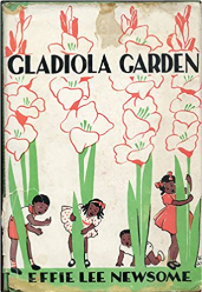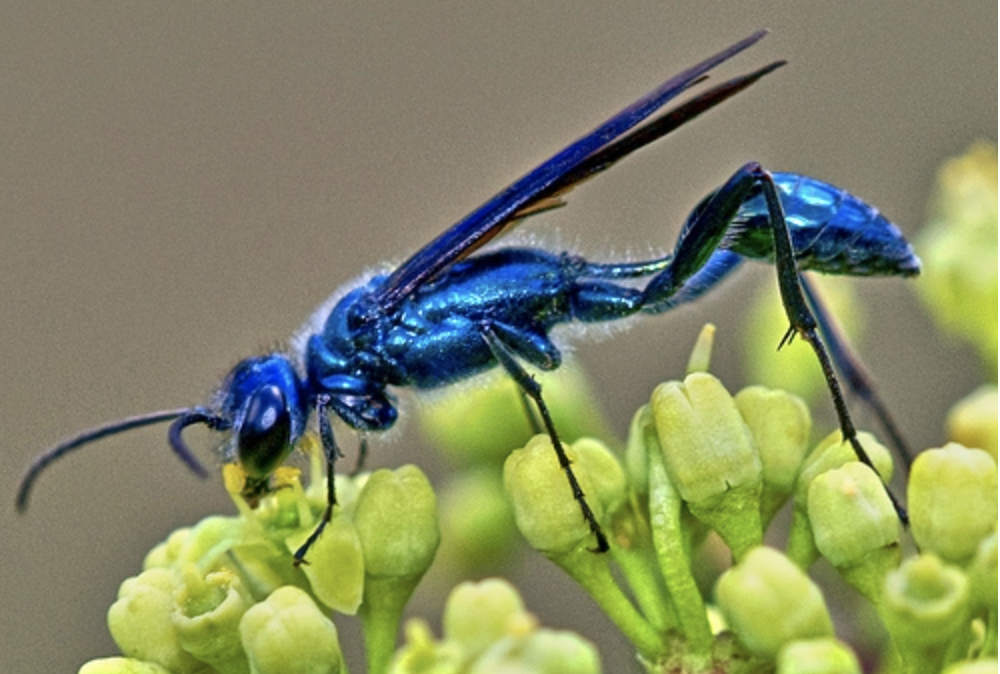Mother Mud-Dauber Wasp
By Effie Lee Newsome
Annotations by Karen Kilcup

Mother Mud-dauber hurries all day,[1] Bringing wet mud for her halls, Her funny little walls. What will she hide inside? Guess, if you have not tried. The spiders she stings, Which can’t run away. She puts them alive in her cells, And they stay. Then she lays an egg in each little cell, And closes it with mud, and closes it well. When the eggs come open on some fine day There’ll be spider dinners waiting In the pleasantest way.[2]
Newsome, Effie Lee. “Mother Mud-Dauber Wasp.” Gladiola Garden: Poems of Outdoors and Indoors for Second Grade Readers. Washington, DC: Associated Publishers, 1940, 21.
[1] Mud-dauber wasps come in several different varieties and colors, but many are beneficial in the garden, where they eliminate pests. The females build the nests, which look like concrete rectangles and are often attached to walls or ceilings, or under eaves.
[2] These wasps are natural predators of spiders, and poisonous black widow spiders are among their favorite prey. Many are quite beautiful.

Contexts
Newsome worked among the many celebrated writers of the Harlem Renaissance, who included Langston Hughes, Countee Cullen, James Weldon Johnson, Zora Neale Hurston, and Anne Spencer, many of them poets. Among her noteworthy contributions to that movement was her writing and editing for W. E. B. Du Bois’s magazine, The Crisis, the official publication of the NAACP (National Association for the Advancement of Colored People). As John Claborn points out, Du Bois’s political goals embraced the idea of access to natural spaces, and the magazine featured environmental writing by such notable authors as Arna Bontemps, Claude McKay, and Hughes. Newsome contributed to and edited “The Little Page” (“Whimsies for the Younger Folk”), where much of her work emphasized nature. Whimsically using the mother-offspring relationship, this poem teaches natural history about insects that children may initially find fearsome or repugnant.
Resources for Further Study
- Claborn, John. “The Crisis, the Politics of Nature, and the Harlem Renaissance: Effie Lee Newsome’s Eco-poetics.” Civil Rights and the Environment in African-American Literature, 1895-1941. New York: Bloomsbury Academic, 2017.
- “Effie Lee Newsome, 1885-1978.” Poets.org. This site provides access to seven of Newsome’s poems.
- Newsome, Effie Lee. Gladiola Garden: Poems of Outdoors and Indoors for Second Grade Readers. Courtesy of the New York Public Library, this site provides access to the entire text.
Contemporary Connections
Anonymous. Reading of Newsome’s poem, “The Bronze Legacy.” The illustrations for Gladiola Garden were done by prominent Black artist Loïs Mailou Jones (1905-1998).
Johnston, Amber O’Neal. “African American Poetry: Effie Lee Newsome. Heritage Mom blog.